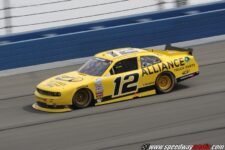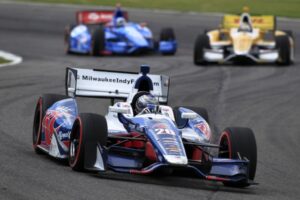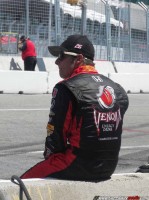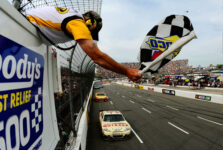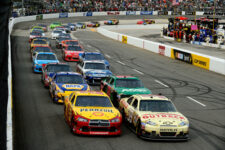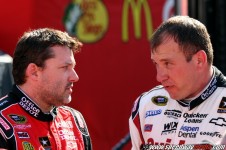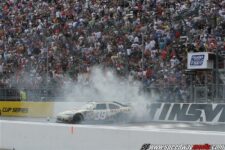Tracing the beginnings of NASCAR is not always easy. You often have to rely on stories passed down through the generations, faded clippings from local newspapers and old photographs. Sometimes it’s difficult to distinguish fact from opinion. But it’s never dull and you always walk away with another piece of the puzzle.
Louis Jerome Vogt Sr. was born in Washington, DC on Sept. 22,
1904. He got his nickname because of his red hair which he inherited from his mother, Carrie. His father, Louie, worked in the government printing office.
Vogt’s parents were friends with the France family and their son, William H. G. France, Sr. (Bill) would become one of Vogt’s closest lifelong friends.
At the age of 11 Vogt quit school and got his first job at a local Cadillac dealership named ‘The Universal Cadillac Corporation’. He was a natural mechanic and by the age of 16 had already risen to the position of shop foreman. He had discovered his calling.
His friend Bill France Sr. worked at a local service station. On the weekends, the two friends spent their spare time at the race track. Vogt loved racing both motorcycles and open wheel cars on the old board tracks. He won the Eastern Board Track Indian Motorcycle Championship four consecutive years.
The treacherous, banked board tracks and fast speeds exhilarated Vogt but the crashes took their toll. On a dirt track at Trenton Motor Speedway, racing in an open wheel car, he wrecked and lost most of his teeth. Another accident while racing motorcycles on a board track, shredded his leather racing gear and left splinters embedded in his flesh. He was in and out of the hospital for three months. During his rehabilitation, he met a volunteer named Ruth Maddox who helped nurse him back to health.
Maddox was from a wealthy family, spoke fluent French and was studying for a career in her father’s insurance business. The unlikely pair soon became a couple. When Vogt decided to move to Atlanta she went with him and they eventually wed.
France and Vogt had taken different paths as their lives progressed. While France honed his gift for organizing and promoting races, Vogt discovered his passion was not racing cars, but building cars.
Vogt arrived in Atlanta at the height of Prohibition and quickly put his abilities as a mechanic to work. He met a famous Atlanta bootlegger named “Peachtree” Williams who hired Vogt and set him up in his shop to work on the cars he used to deliver his product.
Vogt was an exacting employer with high standards. He quickly became well known for his quality workmanship and was a favorite with the local bootleggers. They weren’t the only ones who brought their cars to his garage but the Sheriff’s deputies and the federal revenue agents couldn’t pay as well. Vogt would often say “money equals speed,” so it was probably no accident that the bootlegger’s cars were his top priority.
Vogt’s philosophy was simple. He made his cars stronger and faster than everyone else. It wasn’t long before the racing community took notice. Two of his earliest moonshine clients were future NASCAR drivers Lloyd Seay and Roy Hall.
As Vogt’s reputation grew, so did his income. After a few years he moved Ruth and his two sons to the suburbs into a huge mansion complete with 17 servants.
C. Thomas Vogt who is known as “Little Red” or simply “Red” was born in 1934. “I got that nickname as I have always looked almost identical to Dad.” He is the younger brother to Louis Jerome Vogt Jr., born in 1932.
Although Vogt now had a family, his primary focus was on racing. As a result, his family life suffered. He sent both of his sons to a military school when they were young and was never a big part of their lives. His wife spent most of her time handling the business side of racing.
His son “Little Red” describes his family as “dysfunctional,” and of his father, he says, “In private he was a mean, angry, belligerent, violent man.”
Even so, “Little Red” cherishes the memories of the stolen moments he got to spend with his father. He adored his Dad and speaks proudly of him saying “He had less than a fifth grade education but he was brilliant.”
“When my brother and I were home from military school he never came home but I would sneak down to the shop and try to be around him. He was usually very annoyed with my presence so I hung with the workers and tried to watch Dad and listen to him from afar.”
Vogt demanded perfection at his garage and had a formidable temper. He was known as “the foul mouthed mechanic of NASCAR.” Although he didn’t treat his workers well, he paid them generously and earned their loyalty. His garage was open 24 hours a day and he would often spend days on end there, sleeping on a cot. He used cigarettes, coffee and soft drinks to battle his exhaustion.
He kept the garage spotless and wore the same uniform each day; white pants, white T-shirt and white socks. His tools were displayed neatly on drawers and shelves. All of this was another sign of Vogt’s obsessive personality. But it worked to his advantage. He found that a clean engine lasts longer and runs faster.
Vogt was a genius with cars but having left school at an early age, he was not so adept when it came to the business side of things. His wife, Ruth, usually handled collecting the money from the bootleggers and did the hiring and firing.
The bootleggers called her Mom and she looked the part with her fancy dresses, big hats and high heels, but she was one tough woman. When it came time to collect the money they knew better than to make excuses. It was not uncommon for her to pull a 45 automatic out of her purse if they gave her any problems.
Many suspected that her nagging about money was one of the reasons Vogt stayed at his shop so much. The stress finally took its toll on the marriage and the two divorced. Vogt would later remarry but his family life remained tumultuous.
When Raymond Parks came into Vogt’s life he was able to overlook the flaws and accept Vogt for who he was. They became best friends. He hated the way Vogt treated his sons and went out of his way to be there for them. “Little Red” called him “Uncle Raymond” and the two had a special bond. But above all else, he recognized that Vogt’s expertise with cars was unparalled.
Raymond Parks was the king of moonshine distributors and before long, he trusted Vogt with all his whiskey hauling cars. There was a secret room where the bootleggers could take care of business away from the prying eyes of the federal revenue agents. A “bootleg” safe was located on the third floor to store the money.
Vogt even built a “clean” room in his garage and he only allowed a select few inside. It was also here that he let his natural curiosity lead him to discovering ways to make the cars run faster. It wasn’t long before Vogt’s genius as a car builder helped establish him and Parks as a force to be reckoned with.
Raymond Park’s cousins, “Lightning” Lloyd Seay and “Rapid” Roy Hall convinced Parks to finance them in their racing careers. Parks provided them with quality cars and with Red Vogt as his chief mechanic, they quickly found success.
The two drivers soon became stock car racing’s first stars.
They dominated the sport in the late 1930s and early 1940s but after World War II, they were not much of a factor. Seay was killed in a moonshine dispute in 1942 and Hall was not able to duplicate his earlier success after the war.
When racing was getting off the ground, World War II broke out. Parks served in Germany and spent about three years in the service. He participated in the famous Battle of the Bulge where he spent over 100 days in a foxhole. Parks survived the war with barely a scratch and returned to racing. Fate would soon intervene to bring him together with a new driver.
Red Byron, who had also been in the war, had been racing since 1932 with some success. After the war he moved to Atlanta and met “Red” Vogt. Vogt was immediately impressed with Byron. He was not only a good driver but had an understanding of the strategy it took to win a race. The two men automatically clicked. In late 1945, Vogt introduced Byron to Raymond Parks. These three men would soon become one of NASCAR’s first super teams.
The team had some struggles in the beginning. Byron had been injured during World War II. His bomber had been shot down and Byron injured his hip and nearly lost a leg. His recovery wasn’t easy and it left him with a limp. He had to wear a metal leg brace and an orthopedic boot so driving a car wasn’t easy.
But with some modifications to the clutch pedal by an innovative Red Vogt and a lot of determination, Byron was able to race competitively. The team of Parks, Vogt and Bryon went on to win the first two NASCAR championships ever awarded; the Modified Class in 1948 and the Strictly Stock Grand National Championship in 1949.
Parks and Vogt continued to find success and later fielded cars for Fonty Flock, Tim Flock, Curtis Turner, Jack Smith and others. However Park’s career as a car owner was short-lived. In the mid 1950s, Parks walked away from NASCAR.
Vogt would later team up with an old friend, Peter Depaolo, and The Ford Motor Company team. During his career he also worked with Carl Kiekhaefer, Fish Carburetor, Holman Moody and Smokey Yunick. Yunick credited much of his success to what he had learned while working for Vogt. When General Motors decided to start a new Factory Corvette Race Team, Vogt was their pick as mechanic.
But Vogt was always happiest when he was working for himself and in the late fifties built his own garage in Daytona Beach. However, lack of sponsorship dollars made things difficult.
By the time Vogt retired in 1968, he had amassed an amazing number of victories. The exact amount is unknown. In a speech that Smokey Yunick gave in 1999 to nominate Vogt for the International Motorsports Hall of Fame, he gave the following estimate.
“I believe a conservative estimate of “Red’s” race-winning engines from 1926 to 1968 would be at least 400-450. Certainly, it is very likely even more.”
While Vogt is widely recognized as a master mechanic, there is one aspect of his racing legend that is not so well known. His son, ‘Little Red,” has made it his mission to get his father the recognition he deserves for his participation in the founding of NASCAR.
The famous meeting that resulted in the birth of the organization we now call NASCAR, took place in Daytona Beach at the Streamline Hotel in December 1947. France, Parks and Vogt were among those in attendance.
While Bill France Sr. is generally accepted as the primary force behind the organization of the sport, he was not alone. Raymond Parks played a dominant role by supplying money, cars and advice to France and the newly formed organization.
‘Red’ Vogt’s contributions were also crucial but are not well known.
His son, ‘Little Red’ explains, “My Dad is credited with coming up with the name NASCAR. That’s been recognized.” But that’s only part of the story.
What most people don’t realize is that Vogt owned the charter to the already incorporated NSCRA (National Stock Car Racing Association) in Georgia. The charter also included the acronym NASCAR. In order to move forward, the charter in Georgia had to be surrendered.
The new corporation was going to be formed in Florida. The laws in existence at the time would not allow them to use the same name for the new corporation because that name was being used in another state.
Bill France Sr., Bill Tuthill (motorcycle racing promoter) and Ossinsky (France’s attorney) all got together and convinced Vogt to relinquish his charter. Vogt not only gave up the charter but suggested the name NASCAR (National Association for Stock Car Auto Racing.) The name was voted in unanimously and NASCAR was born.
Vogt passed away in 1991 after a ten-year battle with cancer.
Smokey Yunick, who would go on to become one of the sports’ most revered car builders and mechanics, recalled his time working for Vogt. His words speak volumes about the legacy of “Red” Vogt.
“I met “Red” in 1947. He was 43 and I was 24. He was a very big man with big hands and big, thick fingers and a heavy Southern accent. He had no time for his then long broken first family. I had about a year’s worth of experience in ‘turning money into noise’ when I met “Red”.
I was in absolute awe of his knowledge. Have no doubt about it; I still am! All of us ran second unless his car crashed. His cars just never broke and were always the fastest. If his car did not win, it was usually because of an unavoidable wreck.”
Awards and Achievements:
1980 – National Motorsports Press Association Hall of Fame (Darlington)
1987 -TRW/NASCAR Mechanics Hall of Fame (Inaugural ceremony)
1998 –Smokey Yunick Racing Pioneer Award
1998 – 3.2 Million Dollar Atlanta Racing Garage Complex named “Red Vogt Garage” in honor of pioneer NASCAR mechanic Jerome “Red” Vogt
2002 – Georgia Racing Hall of Fame Inductee
Special Thanks to C. Thomas Vogt –“Little Red”
Smokey Yunick quotes from speech given to nominate Louis Jerome ‘Red’ Vogt Sr. to the International Motorsports Hall of Fame per the Atlanta Constitution Newspaper. Additional quotes courtesy of Neal Thompson, author of ‘Driving With the Devil’



